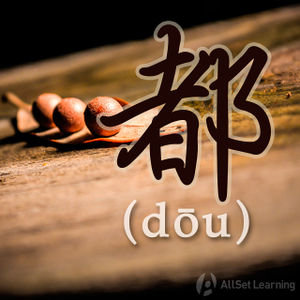Difference between revisions of "Expressing "every time" with "mei" and "dou""
| Line 20: | Line 20: | ||
*他 <em>每</em> 天 <em>都</em> 上 班。 | *他 <em>每</em> 天 <em>都</em> 上 班。 | ||
*请 你 <em>每</em> 两 天 服 一 次 药。 | *请 你 <em>每</em> 两 天 服 一 次 药。 | ||
| + | |||
| + | </div> | ||
| + | |||
| + | == Structure == | ||
| + | |||
| + | 这个结构用于有规律的重复性动作,动作的重复时间以另外一个动作的发生为标志。 | ||
| + | |||
| + | <div class="jiegou"> | ||
| + | |||
| + | 每 +Verb + 次数+ 都 + Adjective/Verb | ||
| + | |||
| + | </div> | ||
| + | |||
| + | == Examples == | ||
| + | |||
| + | <div class="liju"> | ||
| + | |||
| + | *她 <em>每</em> <strong>说</strong> 一 句 话 <em>都</em> 要 停 一下。 | ||
| + | *我 <em>每</em> <strong>看完</strong> 一部电影 <em>都</em> 想跟他讨论。 | ||
</div> | </div> | ||
Revision as of 07:09, 30 January 2013
-
Level
-
Similar to
-
Used for
-
Keywords
"每...都..." (měi...dōu...) is a pattern used to express "every" when talking about a quantitative amount.
Contents
Structure
每 + Number + Measure Word + Noun + 都 + Adjective/Verb
An important note is that if the number is simply just "one", then it's usually omitted.
Examples
- 我 每 个 星期 三 都 去 实习。
- 他 每 天 都 上 班。
- 请 你 每 两 天 服 一 次 药。
Structure
这个结构用于有规律的重复性动作,动作的重复时间以另外一个动作的发生为标志。
每 +Verb + 次数+ 都 + Adjective/Verb
Examples
- 她 每 说 一 句 话 都 要 停 一下。
- 我 每 看完 一部电影 都 想跟他讨论。
See also
Sources and further reading
Books
- Chinese: An Essential Grammar, Second Edition (pp. 87-8) →buy
- Integrated Chinese: Level 1, Part 1 (3rd ed) (pp. 267) →buy
- Modern Mandarin Chinese Grammar: A Practical Guide (pp. 284-5) →buy



